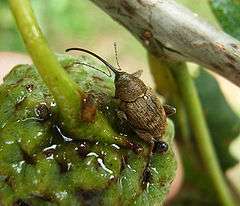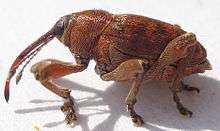Curculio glandium
Curculio glandium is a species of carpophagus weevil, known as the acorn weevil.[1] It is native to eastern North America.[2] It eats by a rostrum, an elongated snout, that is used for piercing. Male/Female differentiation can be determined using the rostrum as female's are longer.[3] The larvae are short, and cylindrical in shape, and move by means of ridges on the underside of the body. Adults can reach a length of 4 to 8 mm.[4]
| Acorn weevil | |
|---|---|
 | |
| Scientific classification | |
| Kingdom: | |
| Phylum: | |
| Class: | |
| Order: | |
| Family: | |
| Genus: | |
| Species: | C. glandium |
| Binomial name | |
| Curculio glandium Marsham, 1802 | |

Taxonomy
Curculio glandium is a member of the genus Curculio, which comprises seed beetles. All members of Curculio have characteristically long rostrums and ovipositors, an adaptation that specifically developed by their reliance on seeds for food and reproduction. [5]
Life cycle
Curculio glandium eggs are deposited in acorns by the adult weevil chewing channels into the fruit. The eggs are then released using an ovipositor, a long, narrow organ featured in female weevils.[5] These do not reach the acorn's embryo and are healed by the plant, sealing the holes and protecting the eggs from parasites. Upon hatching, either one or two larvae consume the fruit. While they may eat the entirety of the acorn, the larvae typically do not consume the embryo itself.[6] Curculio glandium live throughout winter in the larval stage. The larvae are freeze avoidant, preventing their internal body fluids from freezing during the winter.[7][8]
Interactions with other species
Trees
Curculio glandium can pose a large risk to acorn bearing tree populations. They are highly effective at infecting acorns which can cause a widespread number of seeds to be incapable of germination, with a potential of rendering 70-90% of seeds incapable of germination.[1][6]
References
- CSÓKA, György. "Direct Effects of Carpophagous Insects on the Germination Ability and Early Abscission of Oak Acorns". Department of Forest Protection, Forest Research Institute, Mátrafüred, Hungary.
- Udaka, Hiroko and Sinclair, Brent J, "The overwintering biology of the acorn weevil, Curculio glandium in southwestern Ontario." (2014). Biology Publications. 65. https://ir.lib.uwo.ca/biologypub/65
- "Acorn Weevil | NatureSpot". www.naturespot.org.uk. Retrieved 2018-04-01.
- "Archived copy". Archived from the original on 2013-12-03. Retrieved 2013-11-26.CS1 maint: archived copy as title (link)
- Hughes, Joseph; Vogler, Alfried P. (2004-08-01). "The phylogeny of acorn weevils (genus Curculio) from mitochondrial and nuclear DNA sequences: the problem of incomplete data". Molecular Phylogenetics and Evolution. 32 (2): 601–615. doi:10.1016/j.ympev.2004.02.007. ISSN 1055-7903. PMID 15223041.
- Oltean, I (March 2018). "CURCULIO GLANDUM, A PEST WHICH REDUCES THE QUALITY OF THE SEED AT QERCUS PETRAEA IN HILLY TREE FROM O.S. ALMAŞ, D.S. ZALĂU". University of Agricultural Sciences and Veterinary Medicine.
- Udaka, Hiroko; Sinclair, Brent J. (2014-08-01). "The overwintering biology of the acorn weevil, Curculio glandium in southwestern Ontario". Journal of Thermal Biology. 44: 103–109. doi:10.1016/j.jtherbio.2014.02.019. ISSN 0306-4565. PMID 25086980.
- "Freeze Avoidance – The Storey Lab". www.kenstoreylab.com. Retrieved 2018-03-29.
| Wikispecies has information related to Curculio glandium |